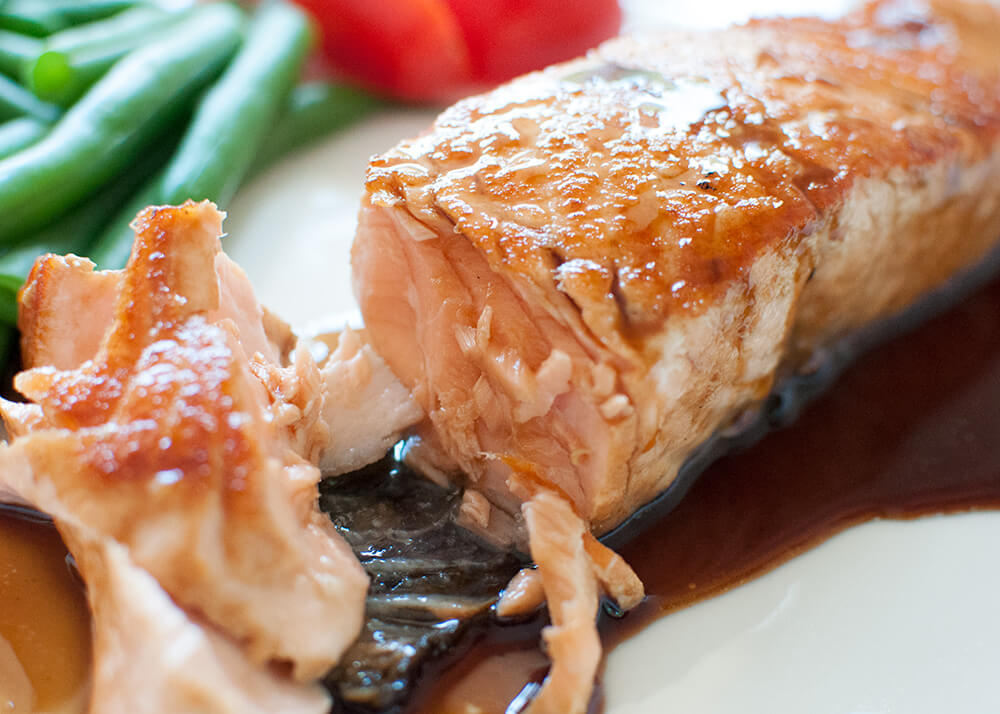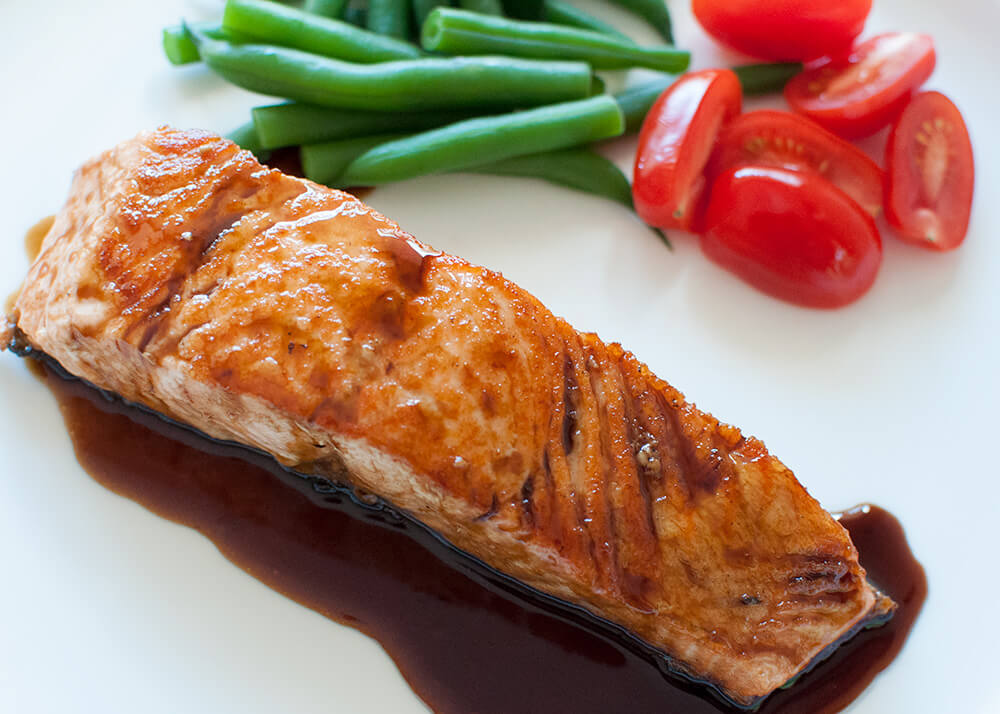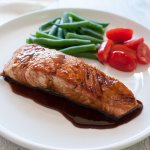Just like my teriyaki chicken, teriyaki salmon is another popular home cooking dish in Japan. It is so quick and easy to make. The teriyaki sauce goes so well with pan-fried fish and it is really tasty.

Teriyaki (照り焼き) is one of the typical cooking method of Japanese cuisine where meat or fish is cooked with soy-based sweet sauce. The word ‘teri’ (照り) means shiny or glossy and ‘yaki’ (焼き) means grill. Because of the sugar in the sauce, the surface of the meat/fish becomes glossy when coated with the sauce.
Sometimes the sauce is basted while the meat or fish is being cooked, but sometimes you simply add the sauce to the pan-fried meat/fish and cook further to condense the sauce. My recipe today used the second method.
There are different versions of teriyaki sauce recipes but in general, it is a mixture of soy sauce, sake, mirin and/or sugar. If you are using the basting method, the sauce should be condensed to become thicker so that the sauce will stick to the fish/meat easily.
The proportion of sauce ingredients are easy to remember – equal portions of soy sauce, sake, mirin plus some sugar. The amount of sugar can be anywhere between half a portion to zero. Today, I did not use sugar at all because mirin gives a sufficient amount of sweetness. Unlike teriyaki chicken, I like the fish to be cooked less sweet. But if you have a sweet tooth, feel free to add some sugar.

Among the many kinds of fish cooked in teriyaki sauce, teriyaki salmon is probably the most popular in Japan. It is called ‘sake no teriyaki’ (鮭の照り焼き). The word ‘sake’ has the same Romaji spelling as drinking sake but the kanji character is different – the kanji character for sake as fish is 鮭, sake as alcohol is 酒. It is very difficult to explain here but the stress in syllables is different between the two to distinguish two different words with the same spelling. Fish ‘sake’ has the stress on ‘sa’ while drinking sake has no stress.
If you make teriyaki with a kingfish fillet, it becomes ‘buri no teriyaki’ (鰤の照り焼き) because kingfish is ‘buri’ (鰤) in Japanese. Other fish fillets usually used for teriyaki are sword fish and Spanish mackerel. As you can see, they have oily and firm flesh, which is best suited for teriyaki fish.
I used salmon fillet but you can use fish cutlet (steak) instead. In the case of a fillet, try to buy a piece that has even thickness and avoid the belly part as it is extremely thin. Then, you will be able to cook the fish evenly.
If you are using a salmon cutlet (steak), you could simply cook the cutlet as is with the back bones in. Alternatively, you could remove the backbones, making two boneless pieces, which becomes almost like the typical Japanese way of cooking teriyaki salmon. You can find how to remove the backbones from the cutlet (steak) in my post, Japanese Salmon Mirin-zuke.

This is another very quick dish to make. It takes just over 10 minutes in total including preparation. The sauce is very tasty and goes so well with boiled rice or potatoes (mashed or boiled).
Yumiko![]()

Just like my teriyaki chicken, teriyaki salmon is another popular home cooking dish in Japan. It is so quick and easy to make. The teriyaki sauce goes so well with pan-fried fish and is really tasty.
- 2 x 200g (7oz) salmon fillets , skin on (note 1)
- ½ tbsp oil (vegetable, canola, sunflower, peanut)
- 1 tbsp sake
- Blanched green beans
- Baby tomatoes
-
Mix the Teriyaki Sauce ingredients in a small bowl or a jar.
-
Pat-dry salmon fillets using a kitchen towel.
-
Heat oil in a frypan over medium high heat.
-
Add the salmon fillets, skin side down and press down the centre of the fillets for 30 seconds or so to avoid the fillets from curing up.
-
Cook for 2 minutes, turn them over and cook further two minutes.
-
Add 1 tablespoon of sake to the pan, place a lid on and steam for about 30 seconds.
-
Remove the lid and turn the fillets over, then add the teriyaki sauce.
-
When the sauce starts bubbling, use a spoon to pour the sauce over the fillets.
-
When the quantity of the sauce reduces to about 2-3 tablespoons (note 3), turn the heat off.
-
Transfer the salmon to a serving plate with green beans and tomatoes, pour the sauce in the pan over the salmon. Serve immediately.
1. I used salmon fillets. The middle part of the fillet was about 2cm (3/4")thick. You can use salmon cutlets (steaks) instead.
Please visit my post, Japanese Salmon Mirin-zuke if you would like to remove the backbone from a salmon cutlet (steak).
2. If you have a sweet tooth, you can add up to 1 tablespoon of sugar.
3. Turn off the heat slightly earlier than the quantity you want as the heat of the pan will continue to condense the sauce.
Hi Yumiko,
Love this recipe! I used to make this a lot when I was living in Japan, and it always turned out great. Recently I’ve been making it in the Netherlands, but for some reason the sauce never thickens up even after reducing it. I’m wondering if it could be because the sake we have is not a Japanese brand. What do you do if the sauce is still too thin? Thanks for your help!
Hi Bonnie, I don’t think the sake is the cause of your problem.
One possible reason for the sauce not thickening is having too much oil in the pan. Chicken, especially with the skin on, produces a lot of oil when cooked. You need to get rid of the oil and wipe the pan while leaving the cooked chicken in.
My sauce, after condensing will not become sticky like some teiryaki sauces that you could buy from Asian grocery shops. Mine is only slightly sticky. If you prefer a very thick sticky sauce, I would suggest that you add a small amount of cornflour/corn starch to the sauce.
Hi Yumiko, somehow I missed your reply, but thank you so much for this advice! I will try that next time 🙂
Hello! Thanks for sharing this recipe. I have tried it many times already and my husband loves it. I am just wondering how to cook it for a bigger crowd. I want to cook it for our friends and relatives but doesn’t know how to proceed since many pieces of salmon cannot fit in a pan. Do you have any tips that you can share?
Hi Lez, I have not tried this but how about placing browned salmon fillets on a oven tray, and continue to cook with teriyaki sauce in the oven? Use a large foil to cover the tray in place of a lid and the oven needs to be hot as the sauce needs to bubble.
Can you use a salmon fillet that’s skinless for this recipe?
Hi Eileen, yes, you can use it. Just be careful when turning it over not to break the fillet as there is nothing to hold the meat together.
Hi Yumiko
I have your Japanese cheesecake in the oven which my sister requested for her birthday tomorrow. It is so good . I will try your teriyaki salmon recipe tonight along with Mabodofu. I might as well continue with the Japanese theme tonight. Thank you for the inspiration to cook Japanese food at home. I trust your recipes. Kind regards.
Hi Ana Maria, It sounds great. Thanks for trying my recipes! Let me know what your sister thinks of the Japanese Cheesecake.
Hello yumiko, I think my favorite Japanese recipe is teriyaki salmon, so I like to read different recipes and I have noticed that many other recipes that require fish usually add salt or sake to fish, which of the two options is better? I’ve also seen some sprinkle flour in salmon, but what purpose will it have?
Hi Ruth, the purpose of adding salt or sake before cooking the fish is to remove fishy smell. Either option is fine. Make sure that you remove excel moisture with a paper towel before cooking. The purpose of sprinkling flour around the fillet is to get the teriyaki sauce cling to the fillet better. The flour absorbs the teriyaki sauce so the fillet will be coated with the thin layer of flavoured cooked flour. I didn’t use it because I pour sufficient amount of sauce over the fillet and you can dip the fish piece into it. Also the surface of the fillet becomes a slightly sticky when flour is on.
I have tried and loved many of Nagi’s recipes, but did not have the courage to try yours because I get the feeling yours are more difficult (I love Nagi’s shortcuts). Yesterday I saw this one and thought it looks simple enough, couldn’t go wrong. And it was indeed delicious! I am very encouraged to try another of your recipes. Any very simple one that you will recommend?
Hi Judith, Teriyaki Chicken is very similar and equally simple. Assuming you are after main dishes, other simple recipes I can list are: Diced Beef Steak (Saikoro Steak) with Japanese Style Sauces, Beef with Daikon and Ponzu Dressing, Japanese Beef Bowl (Gyū-don), Maguro no Zuke-don (Marinated Tuna on Rice), Pork and Potato Stir Fry, Beans and Pork Mince Stir Fry. Most of these dishes take 15 minutes. Marinated Tuna on Rice does not need cooking other than making rice. there are lots of side dishes which are quite simple, too. So, please try some.
Man this dish is so good. Made it again for dinner last night and had leftovers for breakfast this morning. If people took the time to read the ingredients and give it a go, you just wouldn’t go back to the store bought (so salty) teriyaki sauce, it just doesn’t compare to this beauty.
I served with a simple salad with Nagi’s Asian dressing which totally complimented the salmon.
Superb Yumiko.
Hi Barb, I am glad you like it so much. I totally agree with you re store-bought teriyaki sauce.
Hi Yumiko,
So simple, yet so delicious. My family was fighting over the last morsels of salmon! Salmon is going to make a comeback on my dinner table from now on. Thank you, Yumiko!
Hi Michelle, I am glad that your entire family like Teriyaki Salmon so much.
Just awesome is this dish and my oh my how simplistic. The teriyaki sauce is nothing like the bottled stuff I have in the pantry, I’m not sure what to now do with it as your sauce leaves it in the back blocks.
When the salmon was cooked to perfection (if i don’t say so myself), I let it rest whilst steaming in the same skillet bok choy, asparagus, baby spinach & a few cherry toms. I served the salmon over rice.
It’s really, really, really good and authentic! Thanks Yumiko.
Hi Barb, most store-bought teriyaki sauce contains some spices, eg. garlic, which makes the flavour non-authentic as Japanese teriyaki sauce is such a simple combination of few seasonings. I am glad that you loved it. You description of how you served the teriyaki salmon makes me want to eat it now!
Salmon is my favorite fish and teriyaki is really good on salmon. I had no idea that teriyaki means “glossy grill” in Japanese. I just thought it was the name of the sauce and had no other meaning. That’s why I love your Japanese explanations, Yumiko! Thank you for your lessons!
Hi Naomi, thank you!